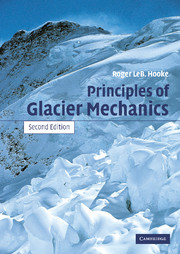Book contents
- Frontmatter
- Contents
- Preface to the first edition
- Preface to the second edition
- Physical constants relevant to ice
- Derived SI units and conversion factors
- 1 Why study glaciers?
- 2 Some basic concepts
- 3 Mass balance
- 4 Flow and fracture of a crystalline material
- 5 The velocity field in a glacier
- 6 Temperature distribution in polar ice sheets
- 7 The coupling between a glacier and its bed
- 8 Water flow in and under glaciers: geomorphic implications
- 9 Stress and deformation
- 10 Stress and velocity distribution in an idealized glacier
- 11 Numerical modeling
- 12 Applications of stress and deformation principles to classical problems
- 13 Finite strain and the origin of foliation
- 14 Response of glaciers to changes in mass balance
- Appendix: Problems
- References
- Index
10 - Stress and velocity distribution in an idealized glacier
Published online by Cambridge University Press: 24 November 2009
- Frontmatter
- Contents
- Preface to the first edition
- Preface to the second edition
- Physical constants relevant to ice
- Derived SI units and conversion factors
- 1 Why study glaciers?
- 2 Some basic concepts
- 3 Mass balance
- 4 Flow and fracture of a crystalline material
- 5 The velocity field in a glacier
- 6 Temperature distribution in polar ice sheets
- 7 The coupling between a glacier and its bed
- 8 Water flow in and under glaciers: geomorphic implications
- 9 Stress and deformation
- 10 Stress and velocity distribution in an idealized glacier
- 11 Numerical modeling
- 12 Applications of stress and deformation principles to classical problems
- 13 Finite strain and the origin of foliation
- 14 Response of glaciers to changes in mass balance
- Appendix: Problems
- References
- Index
Summary
Let us now use Equations (9.32) to calculate stresses and velocities in an idealized glacier consisting of a slab of ice of infinite horizontal extent resting on a bed with a uniform slope. By appropriate choice of the coordinate system, the problem is thus reduced to two dimensions, or plane strain. The ice is assumed to be isotropic and incompressible. We will consider first the case of a perfectly plastic rheology. Then a more realistic nonlinear flow law is used. Our discussion is based on papers of Nye (1951, 1957), which are classics in glaciology.
Although glaciers consisting of such slabs are uncommon, to say the least, there are several reasons for undertaking this calculation. First, it provides an opportunity to apply some of the material discussed in the previous chapter. Secondly, the stress distributions are representative of those which we expect to find in glaciers, and are commonly used approximations when the required assumptions can be justified by the geometry of a problem. Thirdly, the calculations demonstrate the limitations of analytical methods in situations in which boundary conditions are complex. For calculations involving glaciers with realistic shapes, numerical models are required for all but the simplest situations. Finally, the effect of longitudinal stresses on velocity profiles is elucidated.
Solutions for stresses and velocities in plane strain
The coordinate system to be used for the calculation is shown in Figure 10.1: x is parallel to the glacier surface in the direction of flow and z is directed downward normal to the surface.
- Type
- Chapter
- Information
- Principles of Glacier Mechanics , pp. 271 - 287Publisher: Cambridge University PressPrint publication year: 2005



